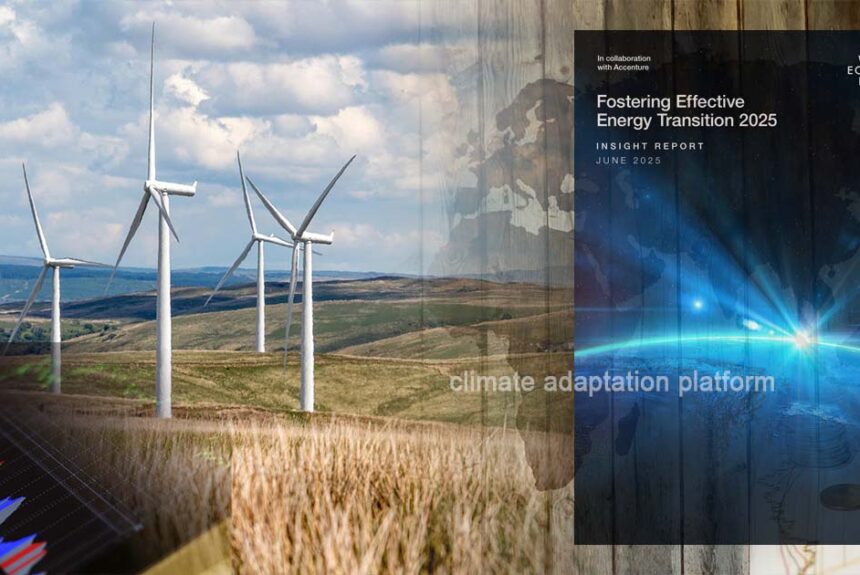The 2025 edition of the Fostering Effective Energy Transition report from the World Economic Forum (WEF) comes at a time of geopolitical disruption, technological innovation, and increasing climate change.
While countries pursue various paths at different speeds, achieving a sustainable and inclusive transformation requires alignment with the country’s ambition, finance, and delivery, guided by market signals, their local context, and international support.
In collaboration with Accenture, WEF published the annual ranking of countries’ programmes on the energy transition. The WEF’s Energy Transition Index (ETI) assigns scores of 0 to 100 to 118 countries, evaluating their energy system performance across three key dimensions: security, equity, and sustainability.
The report highlights improvements in energy equity and sustainability, driven by lower energy prices, subsidy reforms, reduced energy consumption and emissions, and increased adoption of clean energy globally.
However, progress in energy security has been more limited, and the momentum for preparing for the transition has slowed down. At the same time, global energy systems are increasingly affected by climate change, geopolitical issues, economic challenges, and technological disruptions.
Data from 2024 offers a valuable backdrop for the report. It shows that the growth of Artificial Intelligence has caused a 2.2% surge in energy demand. Despite the development of renewable energy and energy efficiency, carbon emissions reached a record of 37.8 billion tonnes.
While clean energy investment reached $2 trillion, a doubling of 2020 levels, a significant gap remains based on the annual amount needed, which is $5.6 trillion through 2030. Annually, growth in investments has also dropped 11% from 24-29% in the previous three years.
Leading Countries in Clean Energy Transition
Here are the top five countries leading in the clean energy transition based on their Energy Transition Index (ETI) scores:
- Sweden, 77.5
- Finland, 71.8
- Denmark, 71.6
- Norway, 71.5
- Switzerland, 71.0
The report notes, “advanced economies, led by the Nordics, continued to top the ETI rankings, supported by diversified energy systems and institutional strength, but faced challenges with grid congestion, high prices and delivery bottlenecks.
Notably, Nigeria made substantial progress, rising from 109th place in 2016 to 61st in 2025, driven by improvements in financial investments and infrastructure. Latvia and the United Arab Emirates posted some of the fastest score gains, demonstrating the power of clean energy adoption and targeted reforms.
China reached fifth globally in transition readiness, mainly due to its innovation ecosystem and recent political commitments, including an economy-wide emissions reduction plan. Japan combined world-leading energy access and strong innovation with renewed momentum through updated emissions targets. The US led in energy security, while India advanced in energy efficiency and investment capacity.”
Emerging Economies face high demand but low investments
While the energy transition is gaining momentum globally, it remains uneven. Roberto Bocca, the Head of the Centre for Energy and Materials at the World Economic Forum (WEF), highlights that 80% of the growing demand for clean energy comes from emerging economies.
However, in the past five years, 90% of investments in this sector have been made in advanced economies. This creates a significant challenge: matching the growing demand for clean energy with sufficient investments.
The report cites that in the future, fast-growing economies such as China, India, and Nigeria will have the most significant increases in energy demand.
The report recommends these five actions to accelerate clean energy systems around the world:
- Adopt stable and adaptive policy frameworks that drive long-term investment and foster cooperation. An example is India’s National Green Hydrogen Mission (2023), which provides targeted incentives based on each state’s industrial strengths, such as Gujarat’s petrochemical capacity, Tamil Nadu’s renewable energy base, and Odisha’s steel production. This supports domestic manufacturing and enhances export potential, aligning with national and global decarbonisation goals.
- Modernise energy infrastructure, particularly grids and storage systems. Saudi Arabia’s Saudi Electricity Company exemplifies this by installing 11 million smart metres, improving real-time energy monitoring, enhancing grid reliability and laying the foundation for increased renewable integration.
- Invest in skilled talent to help boost innovation and execution capacity. An example is Australia’s Clean Energy Training Hubs, which partner with technical and further education institutions (TAFEs), energy companies, and unions to deliver practical training in solar, wind, and battery installations, thereby bridging the gap between market demand and workforce supply.
- Accelerate the commercialisation of clean technology, especially in hard-to-abate sectors. This is exemplified by the US Department of Energy’s $7 billion investment in regional hydrogen hubs. The investment connects public-private partnerships to scale early-stage hydrogen technologies, supporting industrial decarbonisation across transport and manufacturing.
- Enhance capital investment in developing economies. India’s National Investment and Infrastructure Fund (NIIF) is an example, serving as a sovereign-backed platform that partners with global investors to co-finance infrastructure, utilising credit enhancements to de-risk clean energy projects and attract private capital at scale.
The 2025 Fostering Effective Energy Transition report makes it clear: while technological innovation and policy ambition are growing, the global energy transition remains highly uneven. Advanced economies continue to lead, but the future of clean energy hinges on meaningful investment in emerging markets where demand is growing the fastest.
Without coordinated action to close the investment gap, strengthen infrastructure, and scale clean technologies, the world risks falling short of its climate change targets.
Countries that align ambition, financing, and delivery while fostering innovation and inclusion will shape a more secure, equitable, and sustainable energy future for all.
To learn more about the report, please visit the links provided in the “Source” section below.
Sources:
Fostering Effective Energy Transition 2025. (2025 June 18). World Economic Forum. Retrieved from https://www.weforum.org/publications/fostering-effective-energy-transition-2025/
These 5 countries are leading the energy transition. (2025). World Economic Forum. Retrieved from https://www.weforum.org/videos/these-5-countries-are-leading-the-energy-transition-3465f4e964/



Leave a Reply